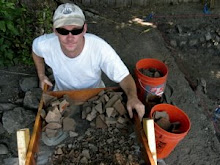Iron and the metals derived from iron decay through several processes, but the main types of corrosion of interest to us are caused by reactions with Oxygen and Chloride.
Oxidation is the most important form of iron corrosion for our study. This corrosion results from the formal combination of oxygen with iron. Oxidation is an electrochemical process involving the formal removal of electrons from iron when it combines with oxygen. Iron has a negatively potential electromotive force (EMF), providing it a greater tendency to lose electrons and form positive ions. In contrast, copper is a more 'noble' metal with a higher EMF. The physical and chemical integrity of cupreous metals or artifacts will thus be preserved for a longer period of time compared to ferrous artifacts.
Electron flow is essential for oxidation. The process of oxidation occurs within a "galvanic cell," also known as an electrochemical half cell. Galvanic cells are created when two different metals or different areas of the same metal allow electrons to flow between them, from the positive anodic area to the negative cathodic area. Electrons flow from the anode to the cathode, breaking down the iron corrosion compounds at the anode. Oxygen bonds with the positive iron ions at the anode. This may occur numerous times to produce various types of oxidation and millions of individual galvanic cells are present on a single corroding artifact. Some people refer to the outcome of all these tiny cells as pitting corrosion.
Another major cause of metals corrosion are salts. In common use, salt refers to a collection of chemicals that include Sodium and Chloride atoms. Conservators are concerned with how these ions electrochemically interact with metals, particularly chlorides. When chloride atoms are ionised they become very reactive, and aggressively seek to interact with other molecules and ions. Concentrations of chlorides are a common salt water, for example, in maritime environments. Chlorides often saturate archaeological artifacts submersed in marine environments. Chlorides react with oxygen in a similar corrosive reaction to that described above.
The presence of chlorides exacerbates problems for conservators. Chlorides readily go into solution, particularly in water. When dissolved into a fluid solution, chloride ions facilitate all the corrosion processes, including what engineers would call galvanic and crevice corrosion. In a general sense, the chemical reactions are all built around the same electrochemical reactions, but these reactions are encouraged or retarded by different structures, environments, and materials (or "material-environment systems" in engineering speak).
The artifacts recovered by Michigan Tech research teams have usually come from terrestrial environments drained by rain and freshwater runoff, thus chlorides are generally not a significant concern. At the West Point Foundry, for example, even though the estuarine environment of that section of the Hudson River could be brackish due to that river's famous tidal flow, most of the artifacts recovered during excavation came from parts of the site above the immediate area of foundry marsh and cove. Our research teams were lucky, as are the landowners The Scenic Hudson Land Trust. The absence of chlorides meant that ferrous iron artifacts recovered from this historic industrial site were inherently more stable than those impregnated with chlorides in solution. This gives field and lab archaeologists and conservators more time to deal with potential corrosion and decay.
Michael Deegan was the first collaborator on the West Point Foundry project to undertake a study of corrosion at the site. He and I co-authored an article summarising our findings after dedicating time in my Archaeological Sciences course, examining corrosion and conservation at the West Point Foundry site with one of our collaborators.
I will summarise the molecular forms created through the corrosion processes in another post. What I hope readers understand from the posts so far is that the decay of metals, particularly iron, is a "natural" electrochemical reaction that occurs unless something prevents it from happening. Factors that enhance or retard the flow of electrons drive both the extent and rate of decay--the presence of liquid water and the presence of chloride irons (salts) are both critically important in the process.
Moreover, these factors do not need to be visible to the naked eye! Microscopic pores, fissures, and stress cracks all absorb molecules from the environment (even when that environment is arid). Corrosion is almost always occurring, even when the object appears to be dry and clean in your storage facility. Corrosion occurs slowly even while the object sits on the shelf in front of you in a museum!
For those undertaking more research on this topic, we have found these sources useful:
Donny L. Hamilton (1997) provided discussions of metals
corrosion which I have found very useful. Other detailed
treatments can be found in N. A. North (1987), Bradley Rodgers (1992, 2004),
and Janet Cronyn (1990).
Cronyn, Janet M.
1990 The Elements of Archaeological Conservation. Routledge, London.
Hamilton, Donny L.
1997 Basic Methods of Conserving Underwater Archaeological Material Culture. Legacy Resource Management Program, United States Department of Defence, Washington, D.C. Retrieved from https://www.denix.osd.mil/denix/Public/ES-Programs/Conservation/Underwater/archaeology.html
on September 12, 2007.
North, N. A.
1987 Conservation of Metals. In Conservation of Marine Archaeological Objects, edited by C. Pearson, pp. 207-252. Butterworths, London.
Rodgers, Bradley A.
1992 The East Carolina University Conservator's Cookbook: A Methodological Approach to the Conservation of Water Soaked Artifacts. Program in Maritime History and Underwater Research, Department of History, East Carolina University, Greenville, North Carolina.
Rodgers, Bradley A.
2004 The Archaeologist’s Manual for Conservation: A Guide to non-Toxic, Minimal Intervention Artifact Stabilisation. Kluwer Academic/Plenum Publishers, New York.
and our article:
Deegan, Michael and Timothy James Scarlett.
2008 The Conservation of Ferrous Metals from the West Point Foundry Site. Bulletin of the New York State Archaeological Association 124: 56-68.
Wednesday, February 13, 2013
Iron, Oxygen and Salt
Subscribe to:
Post Comments (Atom)

No comments:
Post a Comment